![]()
![]()
![]()
Use LEFT and RIGHT arrow keys to navigate between flashcards;
Use UP and DOWN arrow keys to flip the card;
H to show hint;
A reads text to speech;
73 Cards in this Set
- Front
- Back
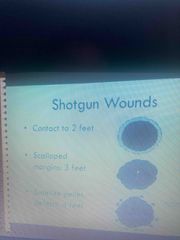
Front (Term) |
Yep |
|
|
This must be collected from the firearm |
Fingerprint and DNA |
|
|
Still on firearm or ejected if an automatic weapon |
Cartridge |
|
|
Retrieved from body during an autopsy |
Bullet |
|
|
Gunshot Residue Analysis (2 TYPES) |
Organic — Inorganic |
|
|
Size comparison of Entry vs. Exit wounds |
Entry — smaller Exit — bigger |
|
|
This is always present in Entrance Wound |
Abrasion ring or Contusion collar |
|
|
Description of tissue in entry vs. exit wounds |
Entry — inverted margins Exit — everted margins |
|
|
Antemortem phenomenon that indicates that the individual was alive at the time when shot — reddish-brown to orange-red coloration |
Powder Tattooing |
|
|
It has a moist gray or yellow appearance. |
Post-mortem tattooing |
|
|
Tattooing is found in what type of range in GSW? |
Intermediate Range GSW |
|
|
Contusion collar is formed when the bullet hits the skin and there is _______ |
Scraping. (Friction is the result) |
|
|
If the contusion collar is wider in superior, then then the trajectory is |
Downward |
|
|
It can tell the trajectory and the position of the victim |
Contusion collar |
|
|
This looks like just a stab wound because of irregularities |
Exit wound |
|
|
Through and through |
Perforating GSW |
|
|
The presumption if the number of gunshot wounds of entrance and exit is even |
No bullet is lodged in the body |
|
|
The presumption if the number of entrance and exit is odd |
One or more bullets might have been lodged in the body |
|
|
Indication of exit wound in skull: |
Bevelling or “punched out” |
|
|
It’s shallow and no perforation. |
Grazed GSW |
|
|
It’s shallow and no perforation |
Grazed GSW |
|
|
Extends down through the subcutaneous tissue; skin is lacerated by the bullet. |
Tangential GSW |
|
|
Shallow through and through; the entry and exit are close to each other. |
Superficial perforating GSW |
|
|
Bullet has passed one part of the body and then re-entered another part |
Re-entry wounds |
|
|
When a bullet enters and does not exit |
Penetrating GSW |
|
|
It’s a tangential source wherein one end of the perforation will resemble a typical entrance defect, while the other end will show external beveling consistent with exit holes. |
Keyhole wound |
|
|
Muzzle of firearm is pressed hard against the skin — that it enveloped the muzzle. Edges of the entrance are seared by hot gases of combustion and blackened soot. Not easily wiped away. |
Hard-contact GSW |
|
|
Grey-black discoloration, soot is deposited in a zone around the entrance. Muzzle is held lightly. |
Loose-contact GSW |
|
|
Type of contact gunshot wound when gases are released by the fired round that went into the subcutaneous tissue. |
Stellate-shaped contact GSW entrance wound |
|
|
If there’s black soot |
Close range GSW: Smudging |
|
|
Front (Term) |
Immediate range GSW: Powder tattooing |
|
|
Type of crime when you shoot a person who is already dead. |
Impossible crime |
|
|
Front (Term) |
Tattooing |
|
|
Front (Term) |
Yep |
|
|
True or false. You can determine the caliber of a bullet based on gunshot wound. |
False. |
|
|
Because the skin is elastic so it’s unpredictable. But when it comes to bone, can full metal jacketed bullets produce entrance wounds in the bone the same diameter as the bullet? |
Yes |
|
|
The most useful aspect to be determine from the PM Examination |
Range of Fire — it can tell us the manner of death whether it’s suicide (contact-immediate), homicide, or accident. |
|
|
This is common with shotguns. The ejection of blood and tissue from an entrance GSW. |
Backspatter |
|
|
Type of investigation where weapon should be present and common in right temple, mouth. |
Suicide investigation/Self-inflicted |
|
|
True or false. A victim may test fire the weapon before inflicting suicide. |
True |
|
|
5 ranges of fire: (CNCID)mi |
Contact Near-contact Close range Intermediate range Distan range |
|
|
Muzzle imprint or star-shaped laceration due to the gases released by the fired round which went into the subcutaneous tissue. Hard or loose and its residue is within the wound track. |
Contact GSW |
|
|
There’s scorching from the muzzle flame. 1-3 inches. It’s the gray zone between contact and intermediate range. |
Near contact GSW |
|
|
Presence of soot, smudging or smoke. 3-6 inches. |
Close range GSW |
|
|
2-3 feet |
Intermediate range |
|
|
Absence of gunshot residue. More than 3 feet. |
Distant Range GSW |
|
|
True or false. Clothing will filter gunshot residue. |
True |
|
|
The absence of evidence is not evidence of absence. |
True |
|
|
It’s a tangential source wherein one end of the perforation will resemble a typical entrance defect, while the other end will show external beveling consistent with exit holes. |
Keyhole wound |
|
|
Muzzle of firearm is pressed hard against the skin — that it enveloped the muzzle. Edges of the entrance are seared by hot gases of combustion and blackened soot. Not easily wiped away. |
Hard-contact GSW |
|
|
Grey-black discoloration, soot is deposited in a zone around the entrance. Muzzle is held lightly. |
Loose-contact GSW |
|
|
Type of contact gunshot wound when gases are released by the fired round that went into the subcutaneous tissue. |
Stellate-shaped contact GSW entrance wound |
|
|
If there’s black soot |
Close range GSW: Smudging |
|
|
Front (Term) |
Immediate range GSW: Powder tattooing |
|
|
Type of crime when you shoot a person who is already dead. |
Impossible crime |
|
|
Front (Term) |
Tattooing |
|
|
Front (Term) |
Yep |
|
|
True or false. You can determine the caliber of a bullet based on gunshot wound. |
False. |
|
|
Because the skin is elastic so it’s unpredictable. But when it comes to bone, can full metal jacketed bullets produce entrance wounds in the bone the same diameter as the bullet? |
Yes |
|
|
The most useful aspect to be determine from the PM Examination |
Range of Fire — it can tell us the manner of death whether it’s suicide (contact-immediate), homicide, or accident. |
|
|
This is common with shotguns. The ejection of blood and tissue from an entrance GSW. |
Backspatter |
|
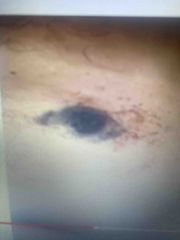
If there’s black soot |
Close range GSW: Smudging |
|
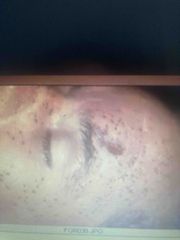
Front (Term) |
Immediate range GSW: Powder tattooing |
|
|
5 ranges of fire: (CNCID)mi |
Contact Near-contact Close range Intermediate range Distant range |
|

Front (Term) |
Tattooing |
|
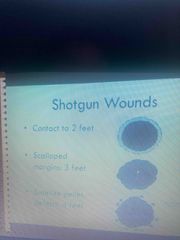
Front (Term) |
Yep |
|
|
Presence of soot, smudging or smoke. 3-6 inches. |
Close range GSW |
|
|
2-3 feet |
Intermediate range |
|
|
Absence of gunshot residue. More than 3 feet. |
Distant Range GSW |
|
|
True or false. Clothing will filter gunshot residue. |
True |
|
|
The absence of evidence is not evidence of absence. |
True |
|
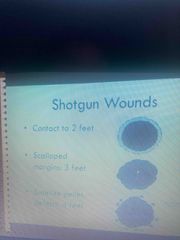
Front (Term) |
Yep |
|

Front (Term) |
Yep |

